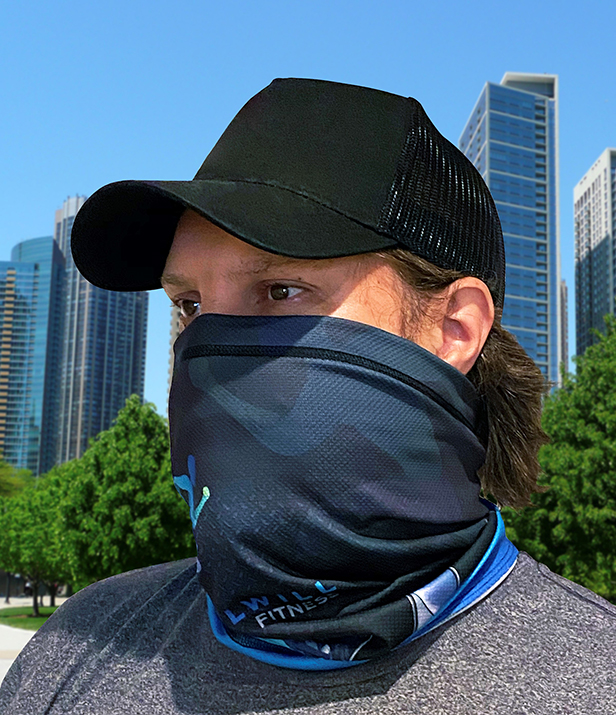News October 14, 2020
New Study Shows Effectiveness of Neck Gaiters
Researchers out of the University of Georgia followed up on a Duke mask study, noting that material and number of layers are more important than face covering style to prevent the spread of COVID.
Two months after a study on masks called neck gaiters into question, new research shows that the tubular accessories may be just as or more effective than cloth masks at protecting against the spread of COVID-19. The findings out of the University of Georgia vindicate what promotional products suppliers have been saying all along: that a face covering’s effectiveness depends largely on what type of fabric it’s made of and how many layers of material are used to construct it.

In August, researchers at Duke University published a study about a simple protocol they’d created to help manufacturers test the effectiveness of their face coverings. The setup included a box, a laser, a lens and a cellphone camera. The researchers used the device to check for droplet emissions when a speaker was wearing one of more than a dozen face coverings. Neck gaiters and bandanas fared the worst in the initial testing, a fact that was quickly picked up by national media.
In the new, not-yet-published study out of the University of Georgia, researchers took the same protocol created by Duke University, but enhanced it further, according to an article published in Yahoo Life. The study used a 3D-printed box designed to reduce air particles, a Class 1000 clean room and a laser. Researchers had an adult male wear four bestselling two-layer cloth masks from Amazon, five of the top single-layer neck gaiters form Amazon and three multi-layer gaiters from Mission (a popular retail gaiter brand). Each covering was test three times.
During the test, the subject stayed quiet for 10 seconds, then said, “Stay healthy, people” five times. The University of Georgia researchers found that one-layer gaiters provided a 77% average reduction in respiratory droplets, compared with wearing no face mask. Multi-layer gaiters had a 96% reduction in droplets. By comparison, two-layer masks had an 81% reduction in droplets.
“There has been a tremendous amount of conflicting information put out in recent months on face coverings, leading many people to believe that gaiters provide little to no protection, relative to masks,” said Suraj Sharma, a professor of polymer, fiber and textile sciences at the University of Georgia who spoke with Yahoo Life on the recent study he co-authored. “This didn’t make sense to us. The type of material and number of layers should determine the efficacy of a face covering, more so than the form factor. We wanted to put that thesis to the test.”
Though Duke scientists have said their study was never meant to be a definitive ranking of mask effectiveness, the backlash against gaiters in the promo world was almost immediate. Jason Emery, vice president of Toddy Gear (asi/91411) estimates that booked sales of gaiters dropped between 50% and 60% within 72 hours of the study being published. Toddy Gear turned the tide with a concerted marketing and sales push, focused on educating clients through short videos and other materials. “We talked about the material being used, the weave of the material and the thickness, or ‘gsm’ of the fabric, most importantly,” Emery said. “Within a week or two, we were able to stabilize the decline and get our sales back to within reach of where they were prior to the study being published.”
Now, he adds, sales are back to normal and “the new study which highlights the same findings which we communicated to our clients only solidifies our efforts.”
Another recent study out of Virginia Tech also found promising results when measuring the effectiveness of neck gaiters. That study analyzed the effectiveness of a single-layer gaiter made of 100% polyester and a two-layer gaiter made of 87% polyester and 13% spandex. The Virginia Tech team found that both gaiters stopped 100% of very large, 20-micron droplets and half of one-micron aerosols.
“We’re happy that other academic institutions are correcting the inaccurate reporting by the Washington Post and others,” said Christopher Bernat, chief revenue officer of supplier Vapor Apparel (asi/93396). “We see that the researchers from Duke again state they were not making a statement about gaiters in their findings.”
Bernat and Vapor Apparel were proactive when the Duke study went viral in August, contacting the Post and other national media outlets to bring more nuance to reporting on the gaiter issue. Bernat notes that Vapor has continued to see demand for its higher-quality gaiters as part of an overall PPE strategy. Vapor recently added a new fleece gaiter to its lineup for cold-weather use.
Of course, even with the new findings, gaiters aren’t universally accepted. Walt Disney World, for example, doesn’t consider neck gaiters or bandanas as acceptable face coverings for guests. And the Centers for Disease Control and Prevention includes a warning on its site that more research is needed on gaiters before determining their effectiveness.
Sharma told Yahoo he’s hoping his study will help change the CDC’s stance and calls neck gaiter bans “very unfortunate.”
“Fighting this pandemic requires us to encourage everyone to wear face coverings, and excluding a very popular face covering is a mistake,” he said. “The CDC is simply saying that they can’t recommend gaiters yet because they haven’t received enough data. This is partly the reason why we wanted to study their effectiveness and ensure there is as much evidence-based information in market as possible for the public.”
